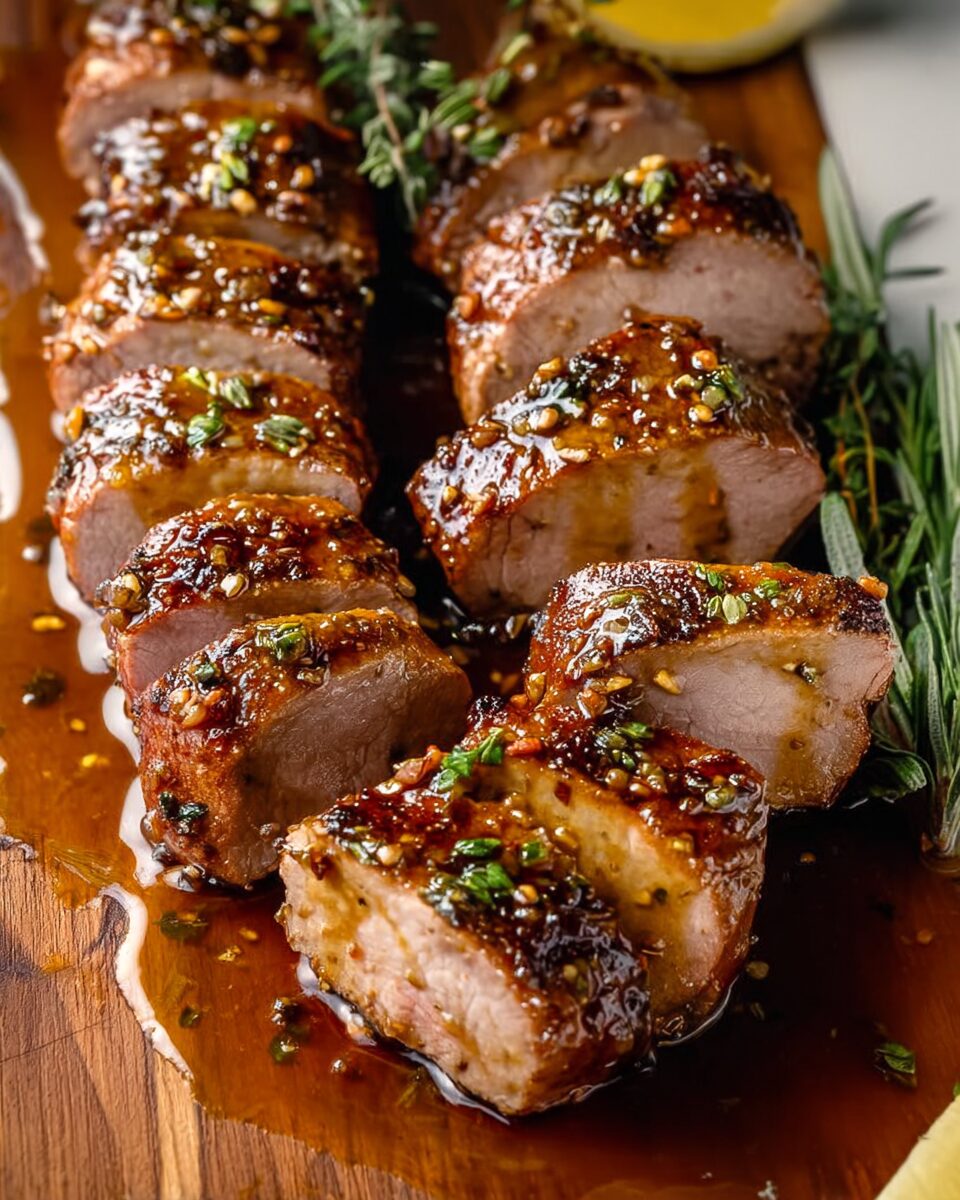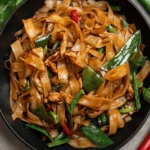The Maple Mustard Pork Tenderloin brings together the best of sweet and savory flavors, creating a succulent and tender dish that’s perfect for any occasion. The marinade, made with maple syrup, Dijon mustard, and apple cider vinegar, adds a delightful tangy sweetness that beautifully complements the richness of the pork. With just a few simple ingredients, this dish comes together effortlessly and is sure to impress.
If you’re looking for an easy yet flavorful dinner option, this dish is a must-try. Whether you’re preparing it for a family meal or serving it for guests, the tender pork with its glossy, caramelized glaze will have everyone coming back for seconds. Plus, the best part? It takes less than an hour to make, so you can enjoy a restaurant-quality meal right at home.
Full Recipe:
-
1 lb pork tenderloin
-
1/4 cup maple syrup
-
2 tablespoons Dijon mustard
-
1 tablespoon apple cider vinegar
-
2 tablespoons olive oil
-
1 tablespoon fresh thyme, chopped
-
2 garlic cloves, minced
-
Salt and pepper to taste
Directions:
-
Preheat your oven to 375°F (190°C).
-
In a small bowl, whisk together the maple syrup, Dijon mustard, apple cider vinegar, olive oil, fresh thyme, garlic, salt, and pepper to create the marinade.
-
Place the pork tenderloin in a resealable plastic bag or shallow dish and pour the marinade over it. Seal the bag or cover the dish and refrigerate for at least 30 minutes (or up to 4 hours for deeper flavor).
-
Heat a large oven-safe skillet over medium-high heat. Remove the pork from the marinade, reserving the excess liquid, and sear the pork for 3-4 minutes per side until golden brown.
-
Pour the reserved marinade over the pork and transfer the skillet to the oven. Roast for 20-25 minutes or until the internal temperature reaches 145°F (63°C).
-
Remove the pork from the oven, cover with foil, and let it rest for 5-10 minutes before slicing.
Prep Time: 10 minutes | Cooking Time: 30 minutes | Total Time: 40 minutes
Kcal: 310 kcal | Servings: 4 servings
History and Origin
Pork tenderloin is a beloved cut of meat across the world, known for its tenderness and mild flavor. It is commonly found in various cuisines, particularly in the United States and parts of Europe. The concept of combining pork with sweet and savory flavors has long been a part of many culinary traditions. The use of mustard with pork has deep roots, dating back to the 17th century in France, where mustard was commonly paired with meats for its ability to cut through the richness of fatty cuts.
As for the maple syrup component, its origins are deeply tied to North American indigenous peoples. They discovered the process of tapping maple trees for syrup long before European settlers arrived. Maple syrup became a staple in early American kitchens, often used in a variety of dishes, from pancakes to savory roasts. The pairing of maple syrup and mustard with pork tenderloin is a relatively modern take, influenced by contemporary culinary trends of balancing sweet, savory, and tangy flavors in one dish.
Though this particular combination of maple syrup and Dijon mustard is often associated with contemporary American cooking, its roots in both French and indigenous cooking methods highlight the timeless appeal of combining pork with sweet and tangy sauces.
Variations and Adaptations
One of the best things about the Maple Mustard Pork Tenderloin is its versatility. The basic recipe can be adapted in several ways to suit different tastes and dietary needs. Here are a few variations you can try:
-
Herb Variations: While the recipe calls for fresh thyme, feel free to substitute other fresh herbs like rosemary or sage. These herbs work wonderfully with the sweetness of the maple syrup and the tanginess of the mustard.
-
Spicy Kick: Add a bit of heat to the dish by incorporating some crushed red pepper flakes or a dash of cayenne pepper into the marinade. The heat from the peppers will perfectly balance the sweetness of the maple syrup.
-
Mustard Variations: While Dijon mustard is the most common choice, you can experiment with other types of mustard such as spicy brown mustard or honey mustard for a slightly different flavor profile. Each type of mustard will bring its own nuance to the dish.
-
Citrus Twist: For a citrusy zing, consider adding a teaspoon of orange zest or a bit of lemon juice to the marinade. The acidity from the citrus will cut through the richness of the pork and bring a fresh, bright flavor to the glaze.
This recipe is also easily adaptable for different cuts of pork. While pork tenderloin is ideal because of its tenderness and relatively quick cooking time, you can substitute it with pork loin or even bone-in pork chops, adjusting the cooking time accordingly to ensure the meat is perfectly cooked.
Nutritional Information
Pork tenderloin is a lean source of protein, making it an excellent choice for a balanced diet. It is low in fat compared to other cuts of pork, such as pork belly or ribs, and provides a healthy dose of essential vitamins and minerals. Here’s a breakdown of the nutritional value of a typical serving of Maple Mustard Pork Tenderloin (approximately 4 oz of cooked pork):
-
Calories: 310 kcal
-
Protein: 30g
-
Fat: 20g (primarily from the pork)
-
Carbohydrates: 15g (from the maple syrup and mustard)
-
Fiber: 1g
-
Sodium: 450mg
-
Potassium: 450mg
-
Vitamin C: 2% of the daily value (from the apple cider vinegar)
-
Calcium: 3% of the daily value (from the mustard)
In addition to being a great source of lean protein, pork tenderloin is also rich in B vitamins, particularly B6, which is important for brain health and metabolism. The addition of maple syrup brings natural sugars that provide a quick source of energy, while mustard offers a modest amount of fiber, vitamin C, and antioxidants.
However, it’s important to keep an eye on the added sugars in the recipe, particularly if you’re watching your sugar intake. While maple syrup is a natural sweetener, it still contributes to the overall carbohydrate count. That said, the dish remains a relatively healthy option when compared to many other rich, heavy meat-based meals.
Serving Suggestions and Pairings
Maple Mustard Pork Tenderloin pairs beautifully with a variety of sides that complement its sweet and savory profile. Here are a few ideas to elevate your meal:
-
Roasted Vegetables: Serve the pork with a medley of roasted vegetables like carrots, Brussels sprouts, or sweet potatoes. The caramelized edges of the vegetables complement the sweetness of the maple syrup glaze.
-
Mashed Potatoes or Sweet Potatoes: Creamy mashed potatoes, whether regular or sweet, are a classic pairing with pork. The rich, buttery texture of the potatoes contrasts nicely with the slightly tangy and sweet pork.
-
Green Beans Almondine: A light, crisp vegetable dish like green beans with toasted almonds offers a crunchy texture that balances the tender pork.
-
Grain Bowls: If you’re looking for a lighter, healthy option, serve the pork over a bed of quinoa or farro, topped with some sautéed greens like spinach or kale. The grains will soak up the delicious maple mustard sauce, making for a satisfying and wholesome meal.
In terms of drinks, a slightly chilled white wine such as Chardonnay or a light rosé works beautifully with this dish. The subtle acidity of the wine pairs perfectly with the richness of the pork and the sweet mustard glaze. For a non-alcoholic option, try sparkling apple cider or a refreshing iced green tea.
Tips and Tricks for Success
-
Don’t Overcook the Pork: Pork tenderloin can easily become dry if overcooked. Use a meat thermometer to ensure the internal temperature reaches 145°F (63°C). This will guarantee a juicy, tender roast.
-
Let the Pork Rest: After removing the pork from the oven, let it rest for about 5-10 minutes. This helps the juices redistribute, making the meat even more tender and flavorful.
-
Marinate Longer for Deeper Flavor: For the best flavor, marinate the pork for at least an hour. If you have more time, marinating it overnight will allow the flavors to fully penetrate the meat.
-
Use a Heavy-Bottomed Pan: A cast-iron skillet or any heavy-bottomed pan ensures even searing of the pork. This helps to lock in the juices and creates a nice crust on the outside of the meat.
-
Reserve Some Marinade: Before marinating the pork, set aside a little bit of the maple mustard mixture. You can use this later to drizzle over the pork when serving for an extra burst of flavor.
Potential Health Benefits
Pork tenderloin is not only delicious but also a nutritious option for a balanced diet. As a lean source of protein, it supports muscle growth and repair. Additionally, the use of maple syrup provides trace amounts of antioxidants, which can help reduce oxidative stress and inflammation in the body. Mustard, particularly Dijon mustard, contains compounds that may support digestion and promote gut health.
Apple cider vinegar, often used in the marinade, has been linked to several potential health benefits, including improved digestion and blood sugar regulation. It may also help promote heart health by supporting healthy cholesterol levels.
When paired with nutrient-dense vegetables and grains, this dish becomes a well-rounded meal that provides a variety of vitamins, minerals, and antioxidants, making it a heart-healthy, energizing choice.
Conclusion
The Maple Mustard Pork Tenderloin is a fantastic recipe that combines simplicity with flavor, offering a unique and delicious way to prepare pork. Its perfect balance of sweet, savory, and tangy notes makes it a versatile dish that can easily become a family favorite. Whether you’re hosting a special dinner or preparing a quick weeknight meal, this dish is sure to impress. So why not give it a try and elevate your next meal with this succulent, flavorful pork tenderloin?





